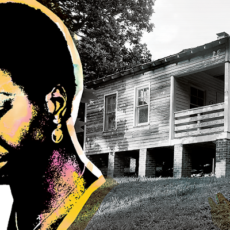- January 18, 2019
- By Carly Taylor ’19
The tiny, weather-beaten cabin in rural Tryon, N.C., doesn’t seem to have much in common with the Washington National Cathedral or the Grand Canyon.
Yet the building, the birthplace and early childhood home of singer and civil rights activist Nina Simone, now shares a place with them on a list of “National Treasures,” thanks to an effort in the School of Architecture, Planning and Preservation’s Historic Preservation Program. And it’s on the path to being saved.
Brent Leggs, a clinical assistant professor, and graduate students Daniela Tai, Kelly Schindler and Chris Bryan spent the Fall 2017 semester researching and writing a report about Simone’s home that recently influenced the National Trust for Historic Preservation’s efforts to preserve and reuse it.
Leggs, the African American Cultural Heritage Action Fund director for the National Trust, proposed the project in a preservation economics course after an African-American artists’ group, Daydream Therapy, purchased the home for $95,000 in March of that year.
“Many African-American historic places are undervalued, underfunded and are currently vacant,” Leggs says. “I was excited about bringing to the classroom a real-world project and teaching students the process for advancing a preservation and business strategy for reuse, but also approaches for building a case of support and engaging the broader public.”
Simone, born Eunice Waymon in 1933, lived in the home for only two years before her family was forced to move due to financial struggles. She started playing piano at age 3 and the Tryon community, recognizing her talent, established a fund to support her piano lessons and send her to private high school.
Rejected by the prestigious Curtis Institute of Music, Simone was instead discovered while auditioning at an Atlantic City bar. She went on to become “the High Priestess of Soul,” blending blues and jazz in hits like “Feeling Good” and “I Put a Spell on You” and turning to social activism with songs including “Mississippi Goddam.” She died at her home in France in 2003.
Historic preservation students in their report highlighted Simone’s legacy, Tryon’s rich cultural history and past efforts to save the home.
Capturing both local and national interest in the project was key, Schindler says. The students found the Tryon community receptive to celebrating Simone, as it has already dedicated a memorial to her. A real hurdle is the house’s unassuming exterior, Schindler says.
“When you get these buildings that don’t look spectacular, you have to figure out a way to convey that story,” she says.
The report suggests an artist residency would be a good use of Simone’s home to “allow the artist the flexibility to engage with the homestead and possibly the community.”
The National Trust in June deemed the home a “national treasure,” signifying its dedication to preserving the endangered site. The organization is creating a sustainable plan for reuse and hopes to open the restored site in the next two years, Leggs says.
Tags
Student Experience